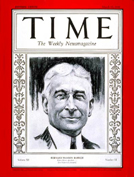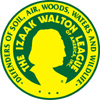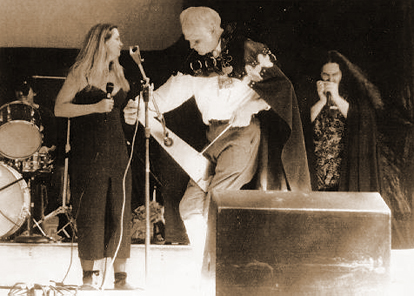| |
 Music
& Elsewhere came into being in 1987, so you probably wouldn’t think that a
date like Wednesday 14th March 1928 could possibly have any direct
connection with it, yeah? You’d be wrong. In Maryland, on the eastern
seaboard of the U.S.A., under the Presidency of Calvin Coolidge, Mrs. Knight
was giving birth to her firstborn son, one Thomas Howerton Owen. 73 years
later, that same firstborn son would be frontman of M&E’s best selling band
of 2001, the great Cincinnati massive that is Blacklight Braille. Et voila!
Now where to begin… I missed the first 70 years of Owen’s life, so the
beginning for me was when he first made contact in the Spring of 1998. I
recall a rather large package of around 10 CD’s arriving and my not quite
believing my eyes and ears. A fluctuating musical collective of 15-20
performers, lead by a septuagenarian, playing the most wonderful selection
of fringe sounds? M&E supporters were gonna be awestruck. I can’t tell you
how much I’ve been looking forward to this interview, I just hope I can do
justice to such an epic tale. Sitting comfortably? It’s gonna be a trip… Music
& Elsewhere came into being in 1987, so you probably wouldn’t think that a
date like Wednesday 14th March 1928 could possibly have any direct
connection with it, yeah? You’d be wrong. In Maryland, on the eastern
seaboard of the U.S.A., under the Presidency of Calvin Coolidge, Mrs. Knight
was giving birth to her firstborn son, one Thomas Howerton Owen. 73 years
later, that same firstborn son would be frontman of M&E’s best selling band
of 2001, the great Cincinnati massive that is Blacklight Braille. Et voila!
Now where to begin… I missed the first 70 years of Owen’s life, so the
beginning for me was when he first made contact in the Spring of 1998. I
recall a rather large package of around 10 CD’s arriving and my not quite
believing my eyes and ears. A fluctuating musical collective of 15-20
performers, lead by a septuagenarian, playing the most wonderful selection
of fringe sounds? M&E supporters were gonna be awestruck. I can’t tell you
how much I’ve been looking forward to this interview, I just hope I can do
justice to such an epic tale. Sitting comfortably? It’s gonna be a trip…
MM:
Your first releases on M&E were the excellent “Old Bones & Sacred Stones”
(M&E 450), plus a revamped version of the classic Blacklight Braille album,
“Dietles Tavern – Take Two” (M&E 451), both in July 1998. Turning to the
former, which was subtitled “The Decline And Passing Of King Arthur - a
soundtrack to Arthur’s journey to the other world”, I’d like to explore that
Celtic link. Though at the time of your birth, the big musical craze would
have been the Charleston, you talk of your first musical memories being of
the Scottish, Welsh, Irish, British and Appalachian folk songs you sang, as
a child, with your grandmother. Is there a Celtic heritage in your family,
which are the songs you recall from those early days and how did they come
to influence your later work?
OK:
So here we go – Our family goes back, in good part to Gloucester,
Cornwall, York, and numbers of places in Scotland and Wales. One of my
relations lived in a hall named for the Sun God, Lud.
MM:
Another obvious influence in your work is a deep connection with nature.
Your book, “Rules Of The Game” (CreateSpace Independent Publishing Platform,
2010), talks of your eyes seeing a certain magic in flora and mountains,
endless walks in the coastal woodlands of Maryland et al. It also mentions
your joining the Izaak Walton League (for the benefit of non US readers,
it’s a highly respected American conservation society, founded in 1922,
click on the badge to visit their website) in your teens, of which you are
still a member. How has this interest in nature and conservation come to
influence your writing and what sort of projects have you become involved
with through the League over the years?
 OK:
The Izaak Walton protects nature. There is a British chapter with which we
are affiliated. We are named for that fisherman of old. And we should
protect our outdoors, protect our animals from getting run down on our
highways, protect our animal groups which are being destroyed: elephants,
rhinos. OK:
The Izaak Walton protects nature. There is a British chapter with which we
are affiliated. We are named for that fisherman of old. And we should
protect our outdoors, protect our animals from getting run down on our
highways, protect our animal groups which are being destroyed: elephants,
rhinos.

|
MM:
I recall you once told me that you started out singing ‘blackface’, a-la Al
Jolsen. His 1927 film, “The Jazz Singer”, was not only a pivotal moment in
the transition from silents to talkies, but it also established Jolsen as a
huge star, though anyone trying it these days would probably just be branded
a racist without a second thought. That change has come about in my
lifetime, I remember my parents taking me to see “The Black & White Minstrel
Show” as a child in the 60’s, that was a show entirely in that ‘blackface’
tradition. Only the ladies remained their natural white, which kind of makes
one cringe all the more looking back, even though this was no insignificant
moment in musical history, and I think we need to accept who we have been in
order to fully understand who we are. What are your memories of those
‘blackface’ days, what kind of reactions do you recall from audiences, and
does any of the music of that era still have a bearing on your latter day
work?
OK:
Times past, we could play act: pretend to be people who we were not. And
few words were objected to – if there was no intent to cause harm by the
use. In time we shall get back to that place again: to a time when people
again have togetherness. – That old time had many good songs, songs
forgotten when the new fad, swing, came in. – Again to masking as someone
else. In a short time ago, there was not the communication between
peoples. To get a Chinaman, one could mask as one.
Owen plays the saw; seriously,
it's at the cutting edge of fringe rock...
MM:
Going briefly back to your childhood, appropriately spent in Rockville (you
couldn’t make that up, huh?), one event I know inspired your musical future
greatly was seeing the saw played at the Grand Ole Opry, you now being a
highly proficient master of the art yourself. What are the elements of
country music that have stayed with you, what was it about the saw that
captured your musical imagination, and exactly how big a part did that
original Opry performer’s pretty young daughter have to play in it?
OK:
The saw. This was a thing anyone could play. It took no electricity. And
seldom did it need to compete with electricity created sound. Music, in my
early years, was local – in America. One seldom went very far in an
automobile. Some music went from place to place on 78 RPM recordings. The
first I heard were on a machine wound up by a crank, which was on my
grandfather’s farm. The farm had no electricity. – But one seldom saw what
was not local. People in a far away city saw The Grand Old Opry. And in my
public school years, I never saw a TV. – And the young one who was a saw
player was increasing my knowledge of it. |
|